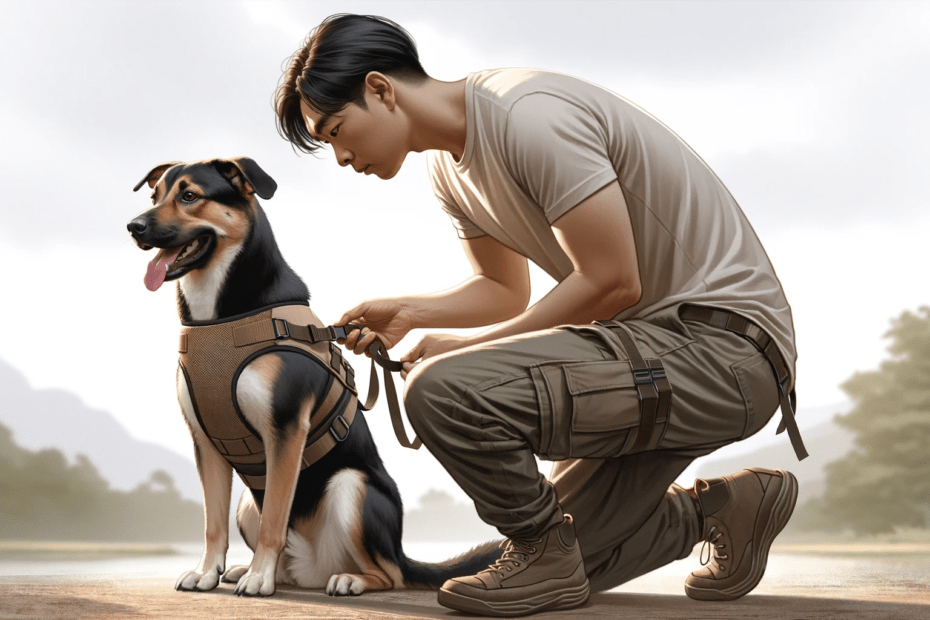Imagine you’re on a hike, and you come across a trail that seems treacherous. You know you need the right gear to navigate it safely.
Well, just like you, your dog needs the proper equipment too. Putting a dog harness on is like giving your furry friend their very own hiking gear. It ensures their safety and comfort while you both explore the great outdoors.
With a few simple steps, you can easily put a dog harness on and have your pup ready to go in no time. So, let’s dive in and learn how to properly put on a dog harness, so you and your four-legged companion can enjoy your adventures to the fullest.
Key Takeaways
- There are three main types of dog harnesses: standard, step-in, and front clip.
- Proper fit is crucial for comfort and safety, so it’s important to measure the dog’s girth, neck circumference, and length to find the appropriate size harness.
- The straps of the harness should be positioned correctly to avoid pressure on the throat and allow for unrestricted movement.
- When attaching the leash, it can be clipped onto the back D-ring for more control or the front D-ring to redirect the attention of overactive dogs.
Understanding Dog Harnesses
To properly put a dog harness on, you need to understand the different types and how they work.
There are three main types of dog harnesses: standard, step-in, and front clip.
A standard harness consists of loops around the dog’s ribs and neck, with a D-ring on the back for the leash clip. It should be adjusted so that you can fit two fingers underneath any strap for a proper fit.
Step-in harnesses require your dog to step into the harness, placing their front feet in the two triangles before clipping the ends together on their back.
Front clip harnesses vary in design, but they all provide more control for overactive dogs. Some have the same loops as a standard harness, while others have a single strap across the chest.
To properly fit a harness, it should be snug but not too tight, and it shouldn’t be able to be pulled over your dog’s head.
Choosing the Right Size
To ensure proper fit and comfort for your dog, selecting the correct size harness is crucial. A well-fitting harness should be snug but not too tight, allowing you to fit two fingers comfortably underneath any strap. This ensures that the harness is secure without restricting your dog’s movements.
When choosing a harness, it’s important to measure your dog’s body accurately. Start by measuring the girth, which is the circumference of the widest part of your dog’s chest. Then, measure the neck circumference and the length from the base of the neck to the tail. Use these measurements to find the appropriate size harness according to the manufacturer’s sizing chart.
Once you have the right size, it’s important to adjust the straps properly. Make sure the harness can’t be pulled over your dog’s head, as this could result in the dog slipping out. The straps should be snug but not too tight, allowing your dog to move freely and comfortably.
Proper Placement of Straps
Position the straps of the dog harness correctly to ensure a comfortable and secure fit for your furry friend. When putting on a dog harness, it’s important to know where each strap should go. Most harnesses have two front neck straps that should be positioned below the dog’s neck. This ensures that the harness fits properly and doesn’t put pressure on the dog’s throat. The chest strap should be placed in a way that avoids crossing the dog’s shoulder joint, as this could restrict their movement and stride.
To find the perfect fit, start by loosening all the straps of the harness. Then, place the harness on your dog’s back and buckle it up. Adjust the harness by tightening the straps until you can fit two fingers between the harness and your dog’s body. This ensures that the harness is snug but not too tight. Make sure to double-check all the straps and buckles to ensure they’re securely fastened.
Once the harness is properly positioned and adjusted, you can clip the leash onto the attachment point provided. This will allow you to have control over your dog while ensuring their comfort and safety. Remember to always adjust the harness and check its fit regularly, as your dog may grow or change shape over time.
Adjusting for a Snug Fit
Ensure a snug fit for your dog harness by adjusting the straps properly. Start by placing the harness on your dog’s neck, making sure it sits comfortably. The straps should be straight and not twisted. Adjust the straps so that you can fit two fingers underneath them. This will ensure a secure fit without being too tight.
Next, move on to the belly straps. These should be adjusted to fit snugly around your dog’s chest, allowing for easy movement. It’s important to check that the harness can’t be pulled over your dog’s head. If it can, tighten the neck straps slightly until it’s secure.
Once you have adjusted the straps for a snug fit, it’s time to secure the harness. Look for the clip or buckle, usually located on the dog’s chest, and fasten it securely. Make sure it isn’t too loose or too tight. You should be able to fit two fingers between the clip and your dog’s chest.
Attaching the Leash
Now, it’s time to securely attach the leash to your dog’s harness for a safe and controlled walk. To begin, make sure the harness is properly adjusted to fit your dog. It should be snug, but not too tight, with enough space to fit two fingers underneath.
Once the harness is adjusted, place it over your dog’s head and pull the harness down over their body. Make sure the front legs go through the designated holes or loops. Once the harness is properly positioned, take the leash and locate the clip.
To attach the leash, simply clip it onto the D-ring located either on the back or front of the harness, depending on your dog’s needs. If your dog tends to pull or jump, attaching the leash to the back D-ring will provide more control. On the other hand, if your dog is aggressive or overactive, attaching the leash to the front D-ring will help redirect their attention and prevent pulling.
Once the leash is securely attached, give it a gentle tug to ensure it’s properly clipped. It’s important to remember that harnesses should fit comfortably and allow your dog to stand and move freely. If you notice any discomfort or restriction, adjust the harness accordingly.
Now that the leash is securely attached, you’re ready to take your dog for a safe and controlled walk. Enjoy your time together!
Frequently Asked Questions
What Is the Correct Way to Put a Dog Harness On?
To put a dog harness on correctly, start by choosing the right size. Then, follow step-by-step instructions on fitting it properly and adjusting the straps. Ensure comfort, consider safety, and train your dog. Avoid common mistakes and troubleshoot any issues.
How Do You Put a True Harness on a Dog?
To put a true harness on your dog, start by choosing the right size and adjusting the straps for a proper fit. Understand the attachment points, introduce the harness gradually, and use positive reinforcement. Troubleshoot issues, ensure comfort, and get your dog used to wearing it. Explore different types of harnesses.
How Do You Put a Harness on a Dog Easy Walk?
To put on an easy walk harness, choose the right size and type for your dog. Follow the step-by-step fitting instructions, using positive reinforcement. Avoid common mistakes and adjust the harness for a comfy fit. Transitioning from a collar? Start with a small breed option. Happy walking!
How Do I Get My Dog to Adjust to a Harness?
To get your dog to adjust to a harness, try introducing it gradually and using treats to create positive associations. Increase the time wearing the harness slowly, use positive reinforcement, and be patient and consistent. Seek professional help if needed, especially for rescue dogs.
Conclusion
Putting on a dog harness is a simple process that ensures your furry friend’s safety and comfort. By choosing the right size and properly placing the straps, you can secure a snug fit for your dog.
Remember, a well-fitted harness is like a protective shield, symbolizing your love and care for your canine companion. So, follow these steps and enjoy worry-free walks with your four-legged friend.





